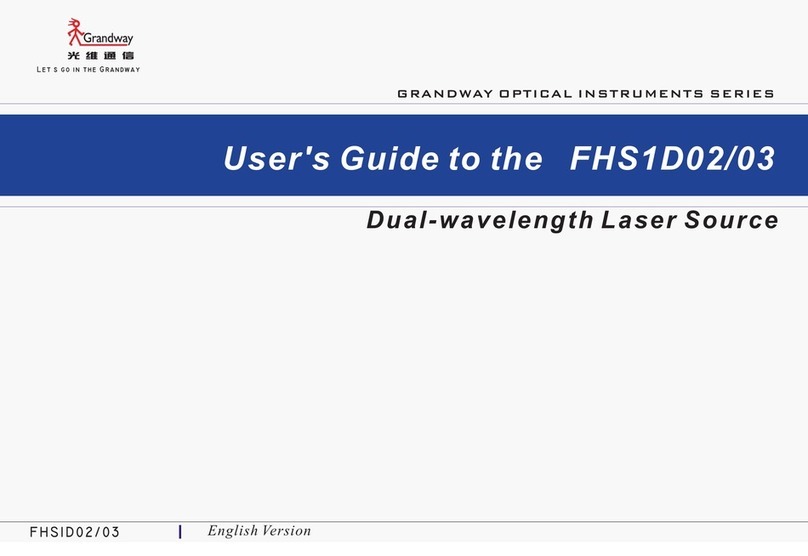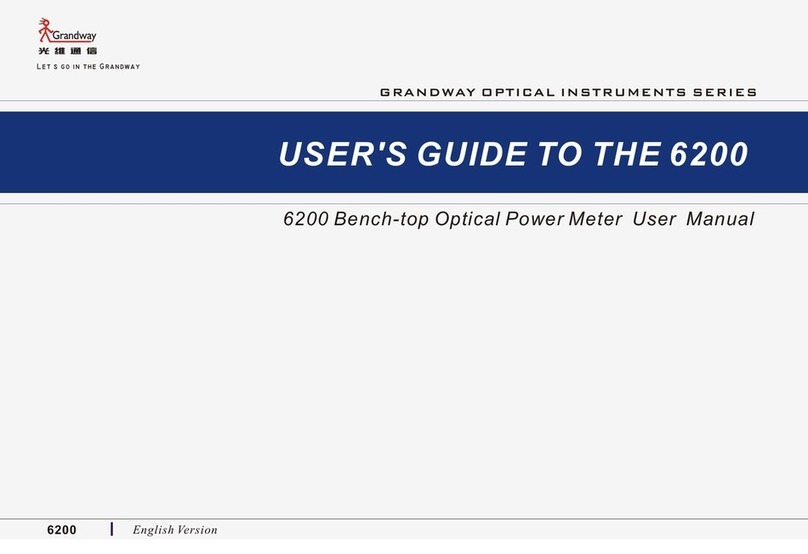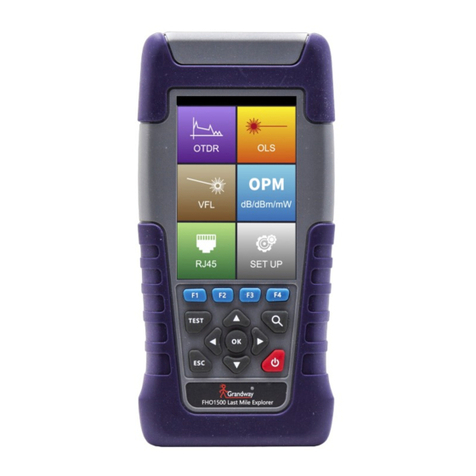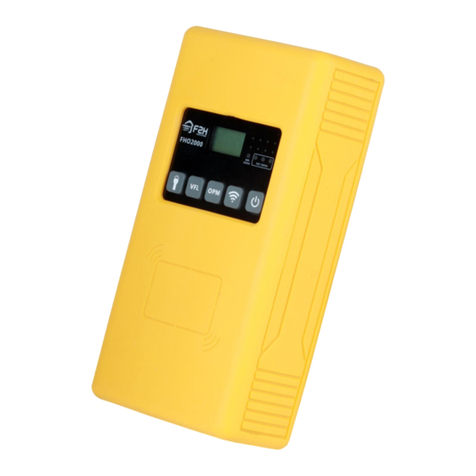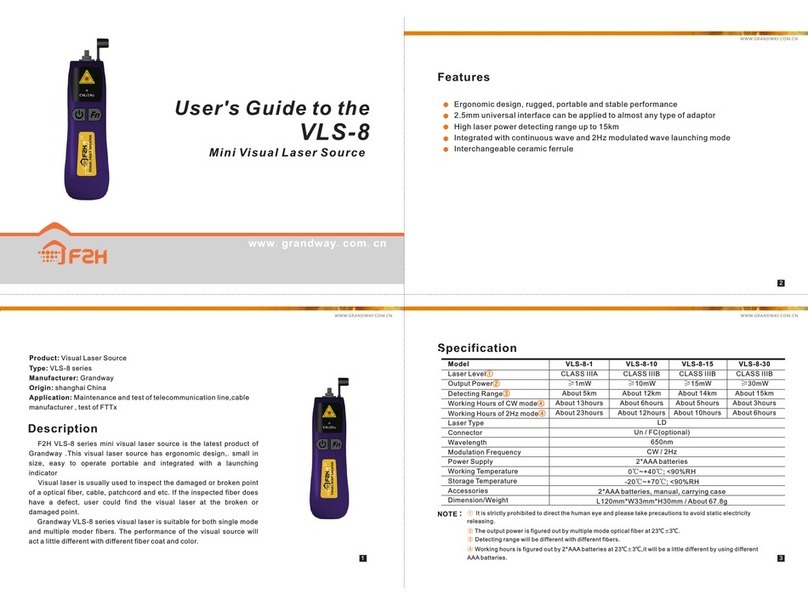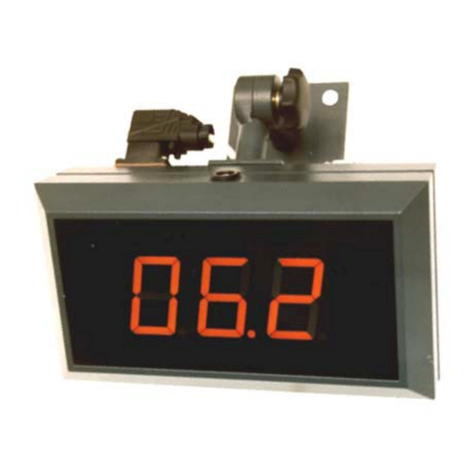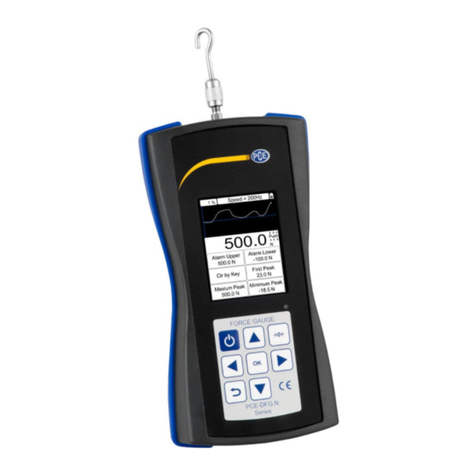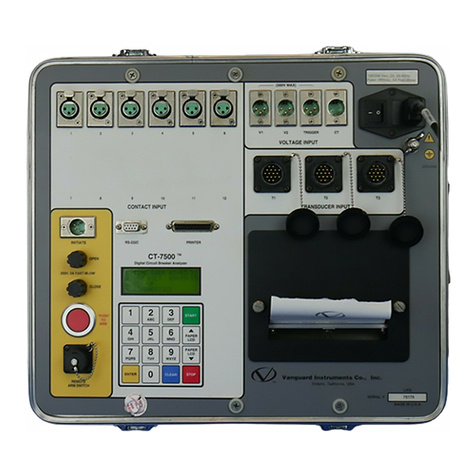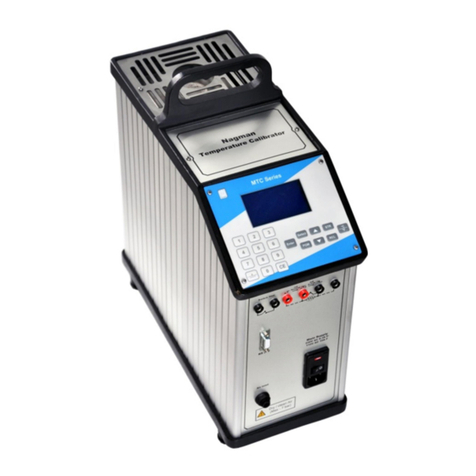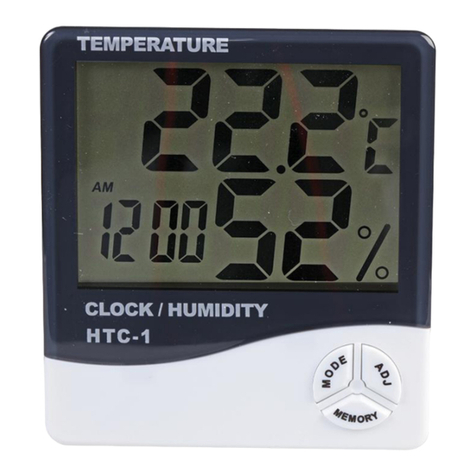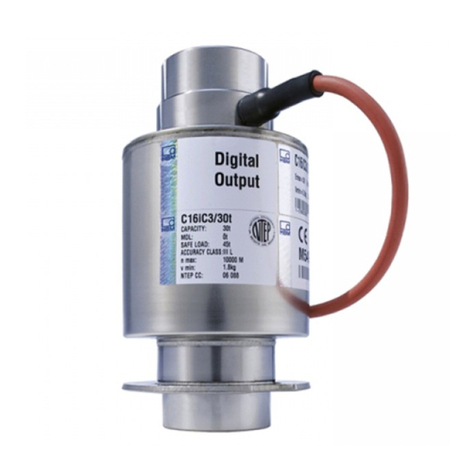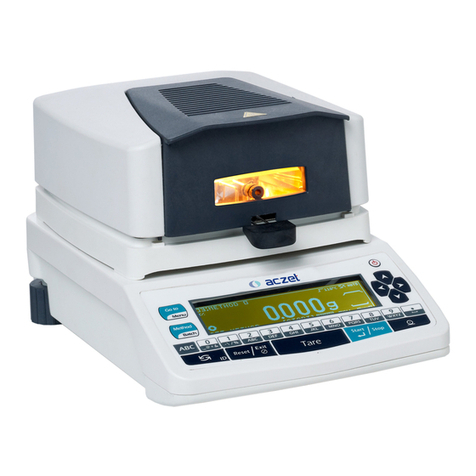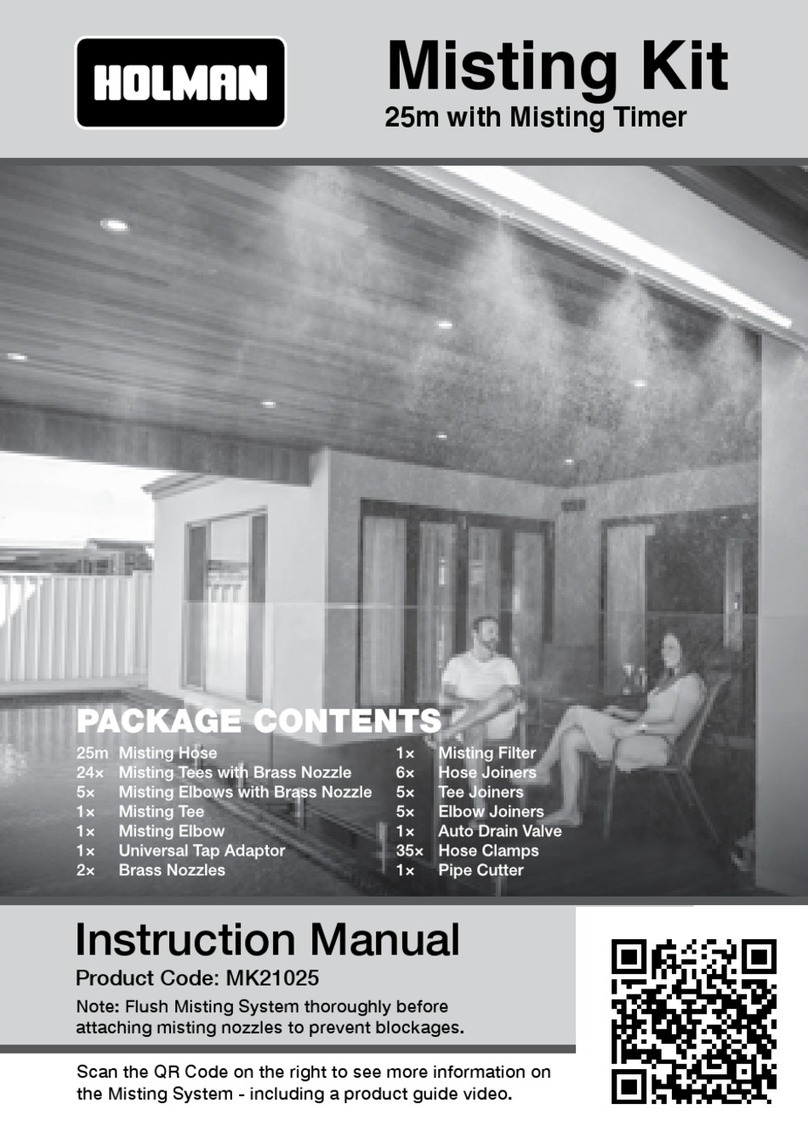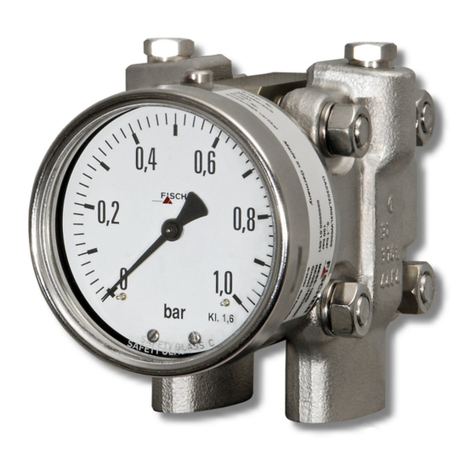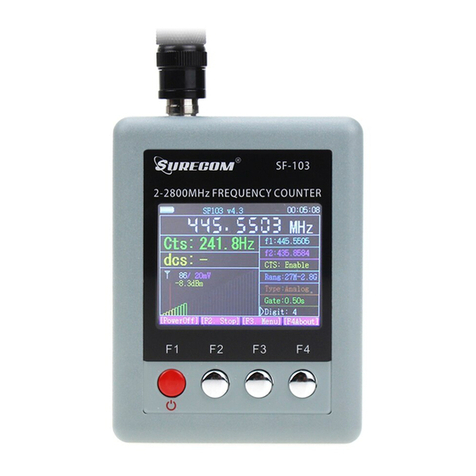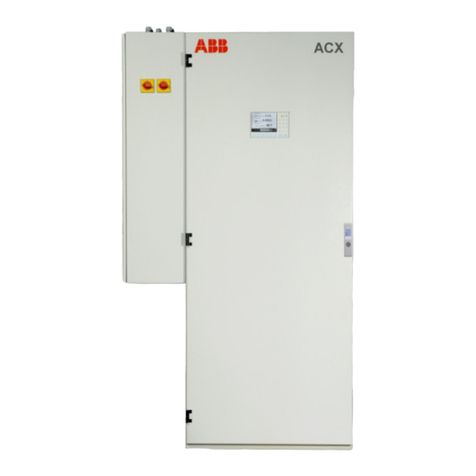Grandway F2H FHO5000 User manual

Let’s go in the grandway!
www.grandwaytelecom.com; +86-21-5445 1260; overseas@grandway.com.cn
2
Foreword
Thank you for purchasing FHO5000 OTDR (Optical Time Domain Reflectometer).This user’s manual
contains useful information about the instrument’s functions and operating procedures and the handling
precautions of FHO5000 OTDR.To ensure correct use, please read this manual thoroughly before
beginning operation.After reading the manual, keep it in a convenient location for quick reference whenever
a question arises during operation.
Note
• The contents of this manual are subject to change without prior notice as a result of continuing
improvements to the instrument’s performance and functions. The figures given in this manual may differ
from those that actually appear on your screen.
• Every effort has been made in the preparation of this manual to ensure the accuracy of its contents.
However, should you have any questions or find any errors, please contact your nearest Grandway dealer.
• Copying or reproducing all or any part of the contents of this manual without Grandway’s permission is
strictly prohibited

Let’s go in the grandway!
www.grandwaytelecom.com; +86-21-5445 1260; overseas@grandway.com.cn
3
Trademark
• Microsoft, Windows, and Windows XP are either registered trademarks or trademarks of Microsoft
Corporation in the United States and/or other countries.
• Adobe and Acrobat are trademarks of Adobe Systems Incorporated.
• For purposes of this manual, the TM and ® symbols do not accompany their respective trademark names
or registered trademark names.
• Other company and product names are trademarks or registered trademarks of their respective holders
Version
Version
Date
Content changes
Note
V1.0
2023-1-1
New PRO Version Released
V1.1
2023-11-2
Add some new functions

Let’s go in the grandway!
www.grandwaytelecom.com; +86-21-5445 1260; overseas@grandway.com.cn
4
Standard Accessory
OTDR standard accessary showed in next table.
Num.
Description
Quantity
1
Main Unit
1
2
Lithium battery
1
3
Power adapter
1
4
Charge cord
1
5
FC adapter
1
6
USB cable
1
7
Quick guide
1
8
Test report
1
9
Wrist strap
1
10
Carrying bag
1

Let’s go in the grandway!
www.grandwaytelecom.com; +86-21-5445 1260; overseas@grandway.com.cn
5
Safety Precautions
To use the instrument safely and effectively, be sure to observe the precautions given in the user’s manual.
Not complying might result in injury or death.
Warning
Use the Correct Power Supply
Before connecting the power cord, ensure that the source voltage matches the rated supply voltage of
the AC adapter and that it is within the maximum rated voltage of the provided power cord.
Use the Correct Power Cord
Use only the power cord that comes with the instrument. Do not use it for other devices.
Use the Correct AC Adapter
Use only the AC adapter specified for the instrument. Do not use it for other devices.
Use Only the Designated Battery pack
Use only the battery pack specified for the instrument. Do not use it for other devices.
Use only this instrument or a charger specified by Gradway to charge the battery pack. If the fast
charge does not finish after fours hours or more, stop charging the battery pack immediately.
To prevent the possibility of electric shock and accidents, always turn OFF the power switch and
remove the AC adapter power supply from the instrument when replacing the battery pack.
Do not throw the battery pack into fire or apply heat to it. This can cause dangerous explosions or
spraying of the electrolytes.
Do Not Look at the Laser Light
Do not look at the laser’s direct ray, reflected ray from a mirror, or indirect ray without the proper
protective eyewear. In addition, avoid being exposed to the laser light. It can cause blindness or
damage to the eye.
Do Not Operate in an Explosive Atmosphere
Do not use the thermocouple in a location where any flammable or explosive gas/vapor is present.
Operation in such an environment constitutes a safety hazard.
Do Not Remove Covers
The covers should be removed by GRANDWAY’s qualified personnel only. Opening the cover is
dangerous, because some areas inside the instrument have high voltages.
Carrying and Moving the Instrument
Remove all power cords and connection cables from the main unit before moving the instrument.
When carrying the instrument, hold it firmly by the handle.Also, if storage media is inserted into the
instrument, always remove the storage media before carrying or moving the instrument. Never leave
the media inserted when carrying or moving. The storage media can become damaged.
Apply Correct Signals to the Optical Connectors
Do not apply light that is —10dBm or greater to the FHO5000 optical Connectors. Doing so may
damage the FHO5000.

Let’s go in the grandway!
www.grandwaytelecom.com; +86-21-5445 1260; overseas@grandway.com.cn
6
Symbol
Icons on the main unit or in manua
Warning: handle with care. Refer to the user’s
manual or service manual.
This symbol appears on dangerous locations on the
instrument which require special instructions for
proper handling or use. The same symbol appears in
the corresponding place in manual to identify those
instructions
Hazard, radiation of laser
apparatus
Direct current
Stand-by (power)
Recycle
Comply WEEE (Waste Electrical
and Electronic Equipment )
Directive (2002/96/EC)

Let’s go in the grandway!
www.grandwaytelecom.com; +86-21-5445 1260; overseas@grandway.com.cn
7
Content
1: OTDR Interface ......................................................................................................................................... 8
2: Preparation ..............................................................................................................................................12
3: Introduction of OTDR .............................................................................................................................. 16
4: OTDR Measurement ............................................................................................................................... 23
5: File Operation ..........................................................................................................................................38
6: Laser Source Module .............................................................................................................................. 45
7: Optical Power Meter Module ................................................................................................................... 46
8: Visual Fault Locator Module (VFL) .......................................................................................................... 48
9: Fiber Link Map Module (FLM) ................................................................................................................. 49
10: Fiber Microscope Module ...................................................................................................................... 52
11: Bluetooth function ..................................................................................................................................54
12: New functions ........................................................................................................................................55
13: Background Information on Measurements ...........................................................................................59
14: Maintenance ..........................................................................................................................................61
15: Diagnosis Center ............................................................................................................................... 62
16: OTDR Specification ........................................................................................................................64
17: Warranty ..................................................................................................................................... 69

Let’s go in the grandway!
www.grandwaytelecom.com; +86-21-5445 1260; overseas@grandway.com.cn
11
1.4 OTDR Module Interface
Num
Function
Description
I
Thumbnail of
current curve
For user's reference to the integrated curve
II
Curve display and
operating area
Display events and curves
III
Event list area
Display event information including:"Type","distance(km)",
"Loss(dB)","T.Loss(dB)","Slope(dB/km)" and "Reflection(dB)",
“Seg.RL”, “Result”
IV
Test condition
information area
Display condition information of test including"PW"(Pulse width),
"WL"(wavelength),resolution of X axis(km/div) and Y
axis(dB/div),distance,averaging and total loss from cursor A to
cursor B.

Let’s go in the grandway!
www.grandwaytelecom.com; +86-21-5445 1260; overseas@grandway.com.cn
13
2.2 Connect the power supply
Using AC adapter
Once connect to AC adapter , power indicator turns red(if it is not fully charged), adapter is charging the
battery , after fully charged power indicator turns green.
Installing Battery
1.Rotate buckle anticlockwise to open.
2.Install battery.
3.Close the cover, rotate buckle clockwise to close.
Caution
Proper charging temperature is: -10~40℃,high charging temperature may shorten battery life.
Charging time is about 5 hours with power on, about 4 hours with power off.
Don't charge battery more than 8 hours.
If the battery is not used for a long time, please charge and discharge it regularly.
Do not keep the battery in a low state for a long time. And stored at room temperature.

Let’s go in the grandway!
www.grandwaytelecom.com; +86-21-5445 1260; overseas@grandway.com.cn
14
2.3 Turning on the OTDR
Press power button(>2s) to turn on OTDR, power state indicator turns green .when power is low some
warning information will display on the screen.
Power state indicator
Green light:Working state or fully charged
Red light:Charging state
Launching state indicator
Green light:Proceed realtime test
Red light:Proceed averaging test
Caution
In case of low power, special icon will appear, and after that for a while FHO5000
will turn off automatically.
If it has not been used for an extended period of time,FHO5000 will turn of
immediately after turned on to protect the internal battery ,please connect the AC
adapter adapter.

Let’s go in the grandway!
www.grandwaytelecom.com; +86-21-5445 1260; overseas@grandway.com.cn
15
2.4 Connecting the fiber
Before connect fiber to FHO5000,clean fiber end first ,the dust which on the end of connector may
damage the optical port or reduce test quality.
Procedure:
1. Put connector against the cleaner.
2. Press the handle of cleaner.
3. Rub each other carefully to clean the contaminant.
4. Repeat procedure 1 and 3.
5. Open the protecting cover of optical port.
6. Insect fiber into optical port carefully.
Caution
Insert fiber carefully into optical port ,
unproper operation may cause the damage
of optical port.
Cleaner
Warning
Before connection make sure that there is no optical signal exist inside the fiber,any signal
which is larger than -30dBm will disturb the sampling of OTDR,even cause permanent
damage of sensor.

Let’s go in the grandway!
www.grandwaytelecom.com; +86-21-5445 1260; overseas@grandway.com.cn
16
3: Introduction of OTDR
3.1 Purpose of Measurement
OTDR shows the back-scatter light power of the optical signal relative to the distance. With this
information, the OTDR could measure a series of important information of an optical fiber such as the
quality of the line, distance of the line and etc.
3.2 Content of Measurement
Event position----- a broken point or the end of the tested fiber
Optical attenuation coefficient of a optical fiber
Single event loss, such as the loss of a connection or a macro bending. Or the loss of a end-to-end line
on the tested optical fiber
3.3 Analyze of Curve
OTDR can auto analyze a tested trace, the position process shows below:
Get the reflection events generated by connectors or mechanical splicer.
Non-reflection events(usually it is splicing points or macro bending).
End: the first point which the loss of it is over the threshold would be scanned as the end of a trace.
Events list: event type, loss, reflection and distance.

Let’s go in the grandway!
www.grandwaytelecom.com; +86-21-5445 1260; overseas@grandway.com.cn
17
Normal Curve
A normal trace shows as above, the A mark is a start-peak and the B mark is a end-reflection-peak. The
tested trace is oblique, the total loss will become bigger with the increasing of the fiber length. The total
loss(dB) divides total length is the average loss(dB/km) of a fiber.
Curve with reflective event
If there is additional reflection peak in a tested trace, this may be caused by a connection point or some
other reasons. Anyway, appearance of the reflection peak shows that the two connecting surfaces of the
connection are smooth. The smoother the connection surfaces are, the higher the reflection peak is.
For an instance, if a broken optical line is under test, the OTDR trace will show a broken point. After a
maintenance of this line, use the OTDR test it again, we may see a reflection peak replacing the broken
point on the OTDR trace, this shows the maintenance is done.

Let’s go in the grandway!
www.grandwaytelecom.com; +86-21-5445 1260; overseas@grandway.com.cn
18
Curve with Broken Point
If the tested trace is just like the figure shows above, this might be caused by several reasons like: a
bad connection between the connector and the lunching port, the optical pulse cannot be launched into
the optical fiber or a short distance broken point of the tested fiber from the initial connection and the
preset testing distance and pulse width is larger.
To fix this problem, we should:
1. Check the connection of the connector and the launching point
2. Reset the test parameters, decrease the preset distance and the pulse width.
If the problem still exists, we could estimate:
1. The connector of the test fiber is broken or polluted.
2. The launching port on the OTDR is broken or polluted.
3. The distance of the broken point of the from the initial connection is too close.
Curve with Non-reflective Event
There is a common phenomenon that an obvious step is on the middle of a tested trace, it often caused
by a fiber bending, fiber knot, being pressed by something heavy or a fuse splicing point. The step means a
bigger loss of a fiber, it is also called event point. If the direction of it is downward, it could be called

Let’s go in the grandway!
www.grandwaytelecom.com; +86-21-5445 1260; overseas@grandway.com.cn
19
non-reflection event. If the direction is upward, we can call it reflection event.
Sometimes, the loss value could be a negative value, it does not means the loss does not exist. It is
common phenomenon called pseudo gain, it is by a connection of two fibers with different back scatter
coefficient, the scatter coefficient of the back fiber is large than the front one's. In addition, the different
refract ratio also can cause the phenomenon. To avoid it, we could test a fiber bi-directionally.
Abnormal Condition
The situation that there is no reflection peak at the end of a trace shows above should be paid attention
on. If the distance of the tested fiber is available and the distance shown on OTDR is not equal to the
original distance, this shows that the fiber might be broken down or twisted and the bending radius of it is
over limited. The distance shown on OTDR is the position of the fault point.
This phenomenon is often used in maintenance. If a fiber is uncertain, we can bend a fiber and make
sure the bending radius is over limited, then use real time testing function of the OTDR to confirm the fiber.
Distance is Too long
This situation often happened in a long distance testing, caused by under-range dynamic range of the
OTDR that the energy of it can not support a long distance transmission or caused by a under-range preset
testing range of distance or pulse width corresponding to the actual fiber length.
To avoid this situation, adjust the testing distance and the pulse bigger and extend the sampling time.

Let’s go in the grandway!
www.grandwaytelecom.com; +86-21-5445 1260; overseas@grandway.com.cn
20
3.4 Fundamental of OTDR
OTDR——Optical Time Domain Reflector is a high precision optical testing meter that use the theory of
Rayleigh scattering and Fresnel reflection. It is widely used in the maintenance, construction and
monitoring of an optical line. All the important parameters like fiber length, optical loss, connection loss,
broken or twisted point and etc. of a fiber can be shown on the OTDR. When the a light transmits along a
fiber, it would be scattered to various directions caused by the difference of come properties of the
transmission medium, this phenomenon called Rayleigh scattering. During the scattering process, some of
the light will be scattered along the absolutely converse direction, this phenomenon is called Rayleigh
back-scattering. It provides some details about the fiber length. The parameters about fiber length can be
got by calculation with the parameter of time(This is the derivation of TD in OTDR——Time Domain).
These back-scattering signals shows the loss level of a fiber and through these information, OTDR can
generates a backward oblique trace which reflects several important attributes of a optical fiber. When the
light, transmitting downward along the fiber, meet a different density medium, a part of the light will be
reflected, this phenomenon is called Fresnel reflection. There are many reasons can cause the changing of
the medium density like a little slot at the splicing point, a broken of fiber or etc. This phenomenon is usually
used to locate the discontinuous point. Compare to the Rayleigh scattering, the consuming amount of the
light in Fresnel reflection is much more then it is in Rayleigh scattering. The power of Fresnel reflection is
tens of thousands times to the back-scattering's. The reflection level depends on the changing grade of
refraction ratio.
Formula of the distance: distance = (c/n)×(t/2)
Here: cis the light speed traveled in vacuum(2.998×108m/s)
tis the delay between launching pulse and receiving pulse
nis the refraction ratio of the testing fiber(specified by manufacturer)
When display the whole trace, each point of the trace represents the average value of several sampling
points. By zoom in and zoom out function, the value of each sampling point can be got.
Table of contents
Other Grandway Measuring Instrument manuals
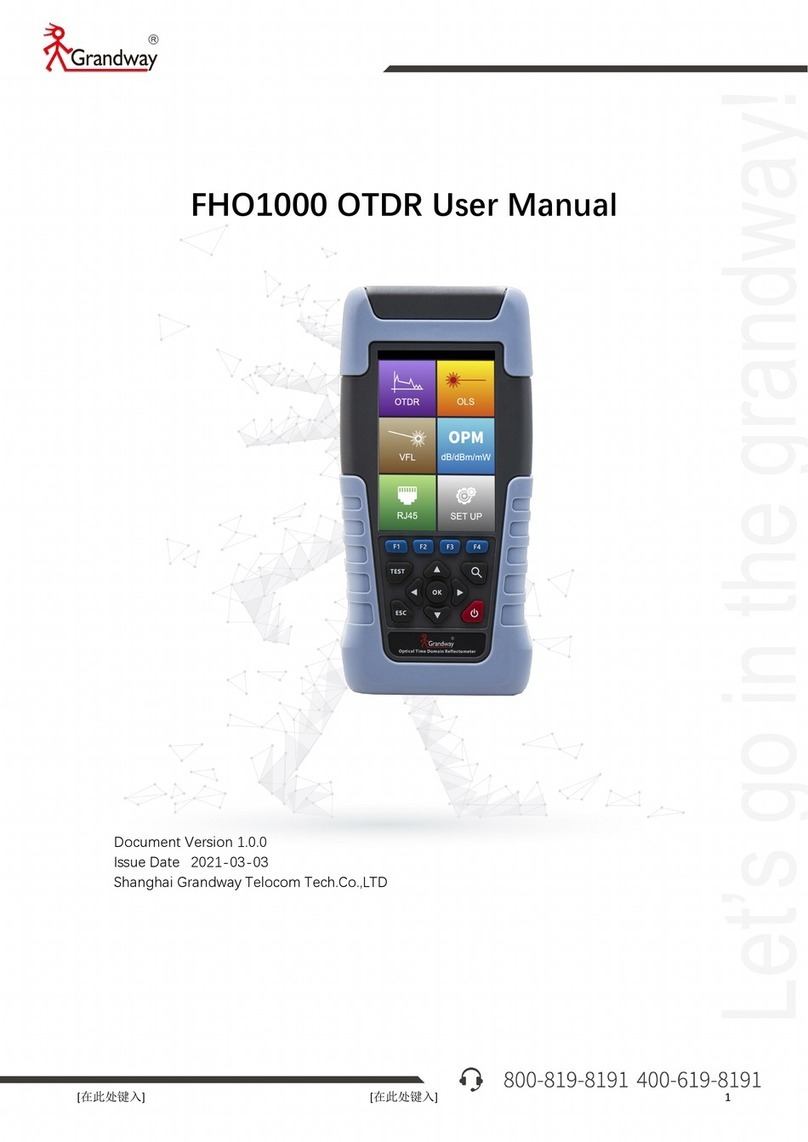
Grandway
Grandway FHO1000 User manual
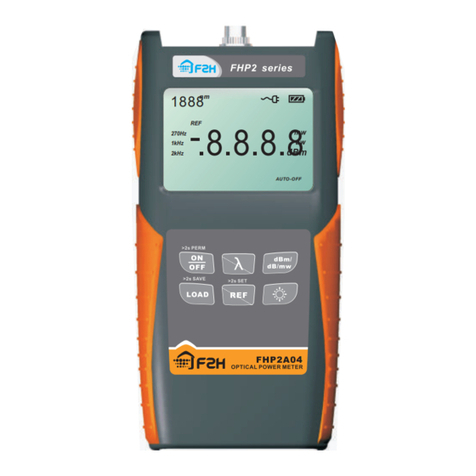
Grandway
Grandway FHP2A04 User manual
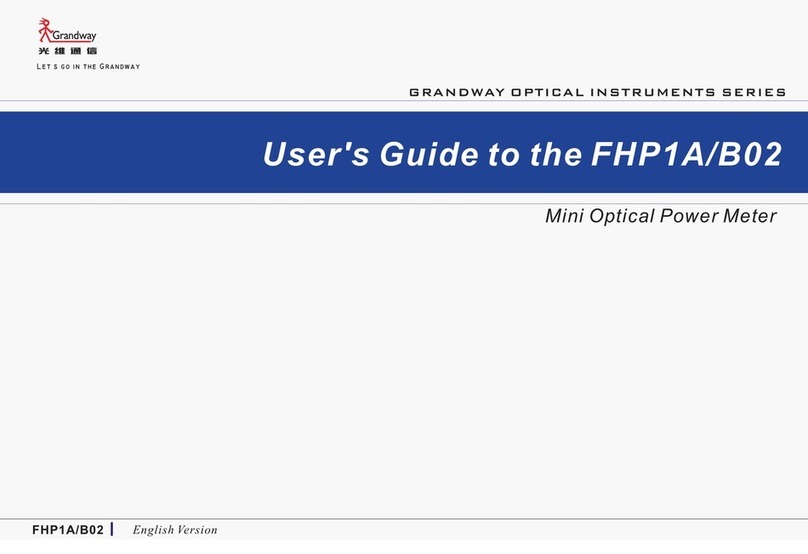
Grandway
Grandway FHP1A User manual
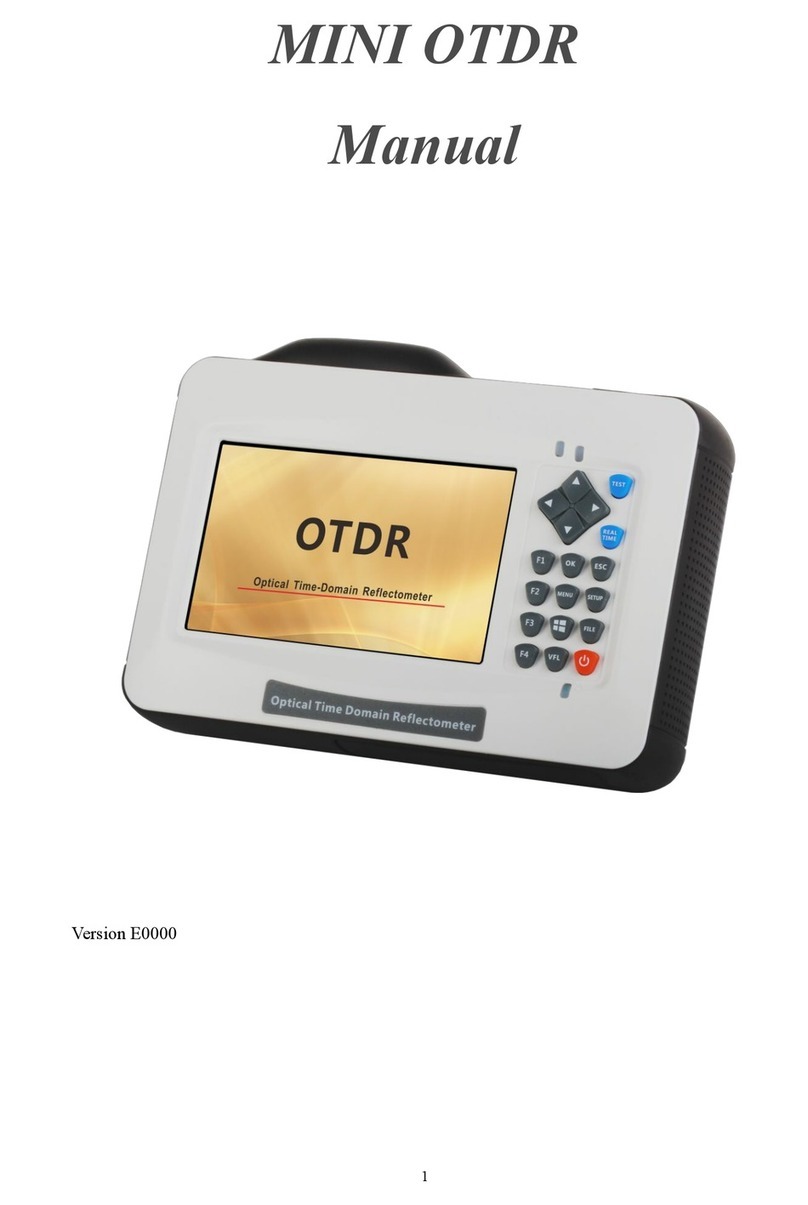
Grandway
Grandway FHO2000-D26 User manual
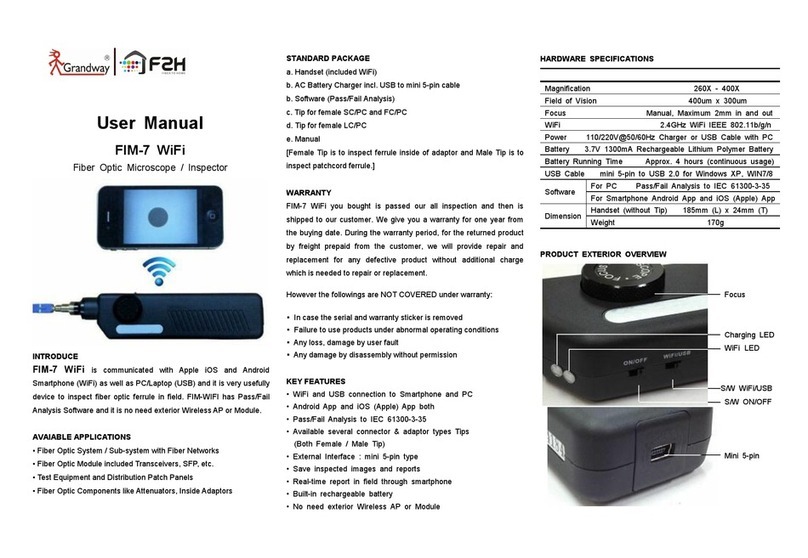
Grandway
Grandway FIM-7 WiFi User manual

Grandway
Grandway FHS2T01F User manual

Grandway
Grandway FHO1000 User manual
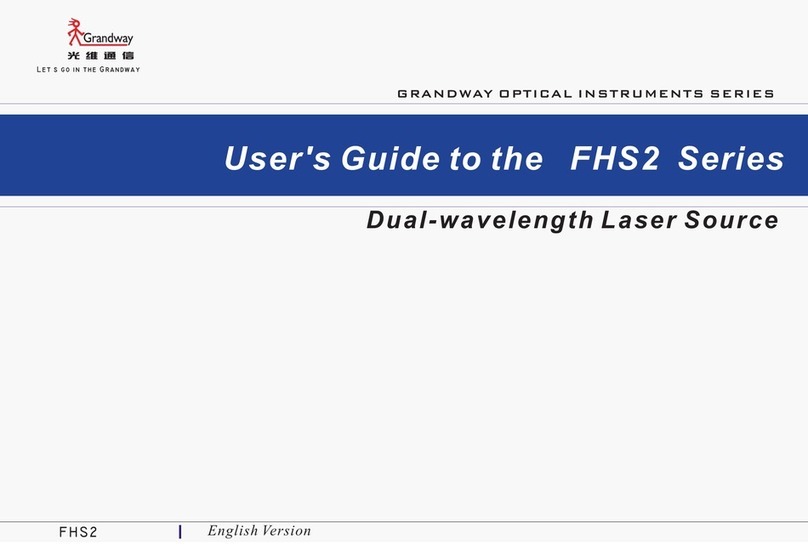
Grandway
Grandway FHS2D02 User manual
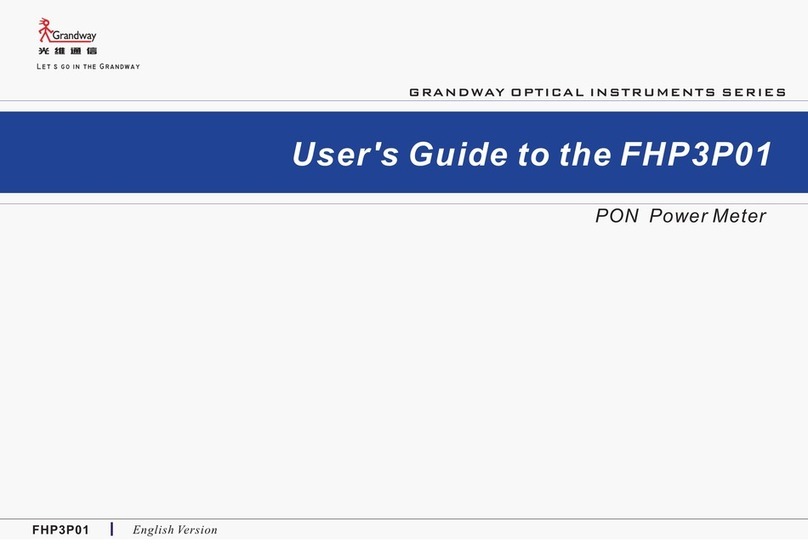
Grandway
Grandway FHP3P01 User manual
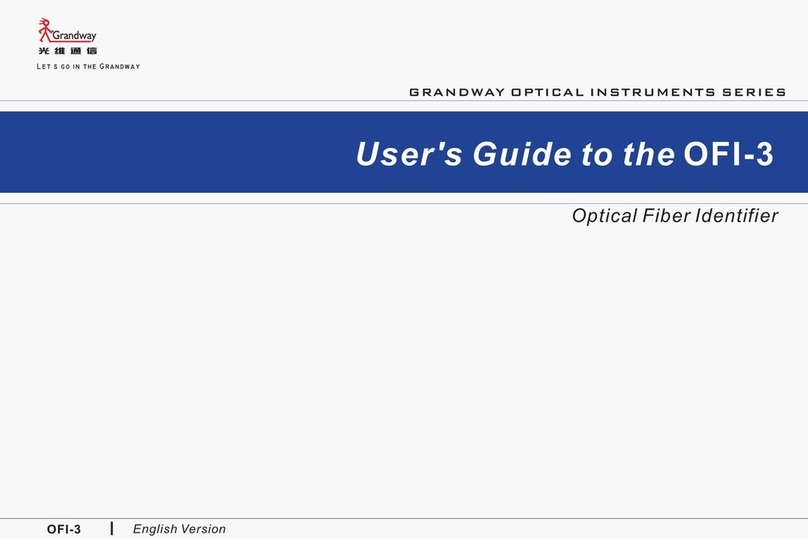
Grandway
Grandway OFI-3 User manual





